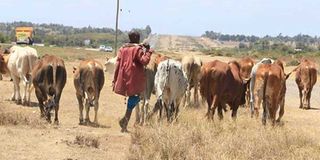Improve markets to lift livestock economy in northern Kenya

A man taking his livestock for grazing. PHOTO | FILE | NATION MEDIA GROUP
What you need to know:
We should go slow on the construction of mega slaughterhouses in every county, instead arid counties should jointly select one strategic slaughterhouse and establish a regional market around it.
This will excite the private sector, offer regional control of the market and eliminate wastage.
Another possibility is branding of meat products from arid counties in order to open new organic market and induce shift from undifferentiated market to a niche market.
Until recently, northern Kenya has been considered as a region of ‘low economic potential’. This is gradually changing with a new ‘resource boom’, particularly in the energy sector. Turkana oil is soon hitting international market and Lake Turkana Wind Power, the biggest wind farm in Africa, was recently commissioned.
EXCLUSION
However, this resource boom couched in nationalistic terms risks reinforcing the deceptive image of the ‘barren land’ that is now ostensibly being ‘put to good use’. What this new narrative does is eclipsing the power of the “pastoralists’ economy”. Although traditionally livestock is the currency of wealth in most African societies, this is not recognised as such in Kenya, which has always had a ‘cash crop bias’, where agricultural produce like tea, coffee so on, form the priority exports.
Such bias has historical origin in colonial Kenya where the settler-centred white highlands constituted the political and economic core. While there was a fair demand for livestock products down country, the market was tailored to the needs of the European settlers who influenced the regulations and governance patterns that barred African herd owners from integrating into national marketing structure. The disruptive measures deployed gave control and autonomy over sales to others while the livestock keepers in arid counties lost the grip of the chain.
The skewed relationship to the market has never changed. To date, more profitable space in the chain is dominated by actors from outside northern Kenya. The long-term exclusion is a factor of demand uncertainty, high operating costs, economic losses that face pastoralists today.
LUCRATIVE
Live animals are traded in spot markets, where livestock are offered and assessed on eye-ball estimations. Body conformity, dental inspection, skin colour, and so on are attributes for pricing. Such pricing mode limits flow of vital market information to livestock keepers, hence they cannot strategically produce for lucrative markets.
To date, prices and demands of livestock trucked to Nairobi are unknown prior to moving them. Local traders seeking to hedge themselves against vagaries of Nairobi markets ferry mix of livestock sizes and types as a buffering strategy. This simultaneously cap their potential profits.
Live animal trading in itself presents multiple risks – quantity losses (reduced weight), quality losses (altered physical characteristics) and economic losses. The traders facing these risks bank on luck. As they embark on the long journey to Nairobi, a common prayer is said for them - “May God make you meet with the market”, a rather secular prayer seeking divine intervention in unpredictable market situation.
As the north increasingly becomes indispensable to the national economy, a discourse to realign arid and semi-arid lands agenda with government and donor priorities is gaining traction. The outcome of this conversation will continue to shape development focus away from food aid, cash transfers to renew interest in investments that “link pastoralists to the market”.
CONNECTIONS
Already, governors from ‘frontier counties’ are doubling efforts to commission mega projects such as multi-million abattoirs, targeting high value meat export markets, complemented by regional discussions on livestock identification, traceability and trans-boundary investments.
Pastoralists are price-takers, with limited market opportunities beyond spot market. Both livestock keepers and local traders are affected by variable and unpredictable prices due to absence of contracts between them and clients.
The colonial and post-colonial measures did not set a strong foundation of connecting livestock keepers or local traders to structured markets in big cities. Hence, their market engagement grew “informally", so to speak, consequently, making them take prices offered without gainfully positioning themselves in a fast changing livestock – meat markets.
So, massive infrastructural investments alone do not offer the market influence needed by the livestock keepers and local traders. What are strategic investments to improve market connections and income for livestock keepers?
Improving markets needs both judicious mix of appropriate policies and a shift in investment types.
UNDIFFERENTIATED
First, we should go slow on the construction of mega slaughterhouses in every county, instead arid counties should jointly select one strategic slaughterhouse and establish a regional market around it. This will excite the private sector, offer regional control of the market and eliminate wastage.
Investment in "software" in form of improved market information flow, price accuracy and choices of potential buyers. Success will result from improved coordination of sales and supply through livestock auctions, which can improve price competitiveness.
Another possibility is branding of meat products from arid counties in order to open new organic market and induce shift from undifferentiated market to a niche market. For this, we need an explicit policy attention to establish reputable enforcement systems for traceability.
Such a shift in investment choices will establish stable markets that will reduce precarity of livestock keepers and local traders and eliminate the need for emergency "livestock offtake" in arid counties that are often poorly conceived and executed.
Dr Malicha is a researcher and expert on African pastoralism and livestock value chain.




